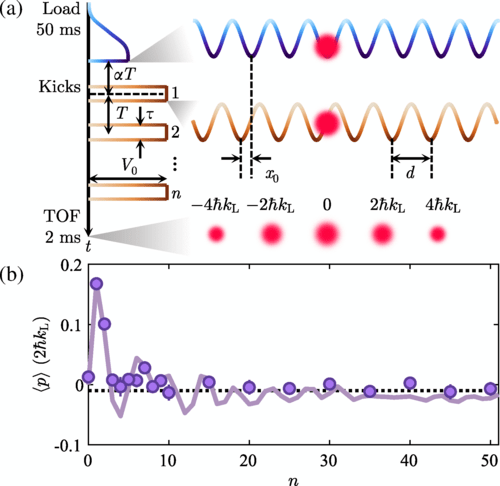Physicists at UC Santa Barbara have experimentally observed a quirky behavior of the quantum world: a ‘quantum boomerang‘ effect that occurs when particles in a disordered system are kicked out of their locations. Instead of landing elsewhere as one might expect, they turn around and come back to where they started and stop there.
Launching disordered electrons away from their localized position and following them to observe their behavior is extremely difficult if not currently impossible, but the team had a few tricks up its sleeve. Using a gas of 100,000 ultracold lithium atoms suspended in a standing wave of light and “kicking” them, emulating a so-called quantum kicked rotor, the researchers were able to create the lattice and the disorder, and observe the launch and return of the boomerang. They worked in momentum space, a method that evades some experimental difficulties without changing the underlying physics of the boomerang effect.
Using their quantum kicked rotor they pulsed the lattice a few dozen times, noting an initial shift in average momentum. Over time and despite repeated kicks, however, average momentum returned to zero.
A particle in an Anderson-localized system, if launched in any direction, should, on average, return to its starting point and stay there. Despite the central role played by Anderson localization in the modern understanding of condensed matter, this “quantum boomerang” effect, an essential feature of the localized state, was only recently theoretically predicted. The team reported the experimental observation of the quantum boomerang effect. Using a degenerate gas and a phase-shifted pair of optical lattices, they not only confirmed the predicted dependence of the boomerang effect on Floquet gauge but also elucidated the crucial role of initial-state symmetries. Highlighting the key role of localization, they observed that as stochastic kicking destroys dynamical localization, the quantum boomerang effect has also disappeared. Measured dynamics are in agreement with numerical models and with predictions of an analytical theory they have presented which clarifies the connection between time-reversal symmetry and boomerang dynamics.
These results showcase a unique experimental probe of the underlying quantum nature of Anderson localized matter.
The paper has been published in Physical Review X.



